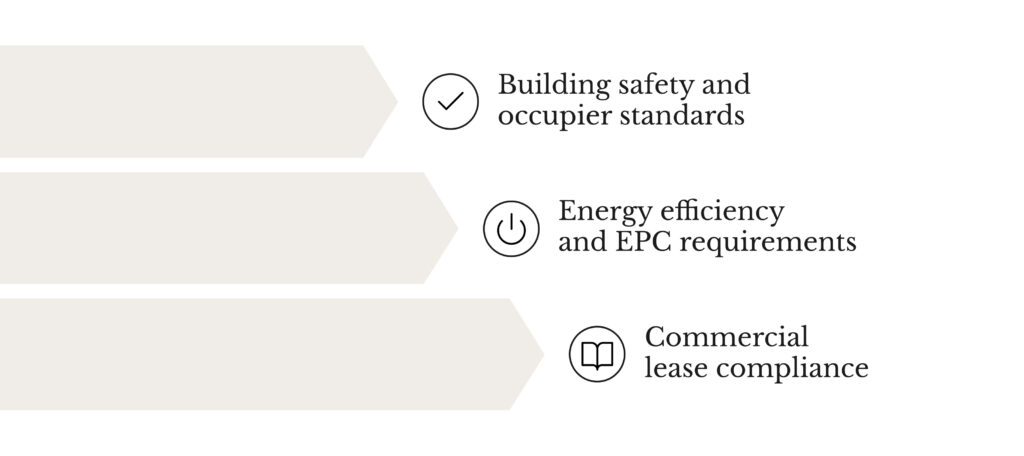What UK portfolio managers need to know to stay compliant and protect asset value.
Commercial property compliance is becoming increasingly complex, as commercial property regulations continue to reshape how portfolios are managed across the UK. As standards evolve across energy efficiency, building safety and leasing practices, portfolio managers are expected to maintain full oversight of each asset under their control. This includes clear visibility across key areas of commercial property management such as compliance, tenant expectations and operational performance.
These regulatory changes directly influence operational strategy. From EPC thresholds to occupier safety obligations, the impact extends to tenant satisfaction, long-term asset value and investment risk.
Non-compliance can disrupt tenant retention, restrict access to finance, trigger legal action and raise questions in institutional reporting. Once issues are identified, reversing the damage can be difficult and time-consuming.
This article explores the main areas of regulatory focus and provides guidance on how to stay compliant and future-ready in a shifting landscape.
Key areas of commercial property regulations in the UK
Commercial property regulations in the UK are evolving rapidly, with growing complexity across multiple areas. For portfolio managers, staying informed and responsive across building safety, energy performance and lease structures is now essential.
These regulations influence every part of the asset lifecycle. From acquisition and refurbishment to lease renewals and disposals, each compliance obligation has implications for value, performance and risk exposure.
Understanding how these requirements are changing, where responsibilities lie, and how to respond at portfolio level is critical. A proactive approach allows managers to reduce regulatory risk, maintain operational efficiency and align with market expectations.
The following sections outline the main areas of commercial property regulation that demand consistent oversight and action.

Building safety and occupier standards
Building safety requirements have increased in complexity, particularly under the Building Safety Act. For portfolio managers, this means more rigorous oversight of fire risk assessments, structural maintenance and safety reporting across all commercial properties — especially those with shared access, vertical infrastructure or mixed-use layouts.

The key risk isn’t limited to legal non-compliance. Delays in meeting safety obligations can make it harder to secure insurance, prompt regulatory scrutiny, or raise concerns among tenants and stakeholders. In some cases, unresolved issues may impact leasing timelines or disrupt tenant satisfaction. For managers, this can create uncertainty around income projections.
Increasingly, occupiers and their corporate stakeholders are scrutinising safety measures as part of their location decisions. A failure to maintain visible, verifiable safety standards may mean losing prospective tenants to more compliant buildings nearby.
Energy efficiency and EPC requirements
The UK’s Minimum Energy Efficiency Standards (MEES) currently require a minimum EPC rating of E, but further tightening may be on the horizon. Consultations are underway to increase the minimum to EPC B for commercial properties by 2030. At the same time, EPC frameworks may soon require more granular data, shorter validity periods and multiple performance metrics.
Portfolio managers should plan ahead for potential changes by reassessing asset performance and developing a phased retrofit strategy that aligns with evolving compliance standards, particularly when planning new development or major refurbishment. This includes auditing the energy performance of existing assets, prioritising those at risk of falling below future thresholds and budgeting for upgrades over multiple years.
The consequences of falling short extend beyond fines or lettability issues. For managers reporting to institutional boards or pension fund investors, potential EPC changes could become a factor in valuation and future asset strategy.
Commercial lease compliance
Lease agreements remain a cornerstone of regulatory compliance. But many portfolios still include legacy leases with outdated clauses, unclear responsibilities or inconsistent approaches to repairs, ESG, and service charges.
The RICS Code for Leasing Business Premises provides a recommended framework, but managers must ensure their actual leases reflect operational realities.
Where this is not the case, issues can arise around who is responsible for compliance-related works (such as EPC upgrades or fire safety improvements), who pays for those works and whether they are recoverable through service charge. Poorly drafted leases also create friction in occupier relationships and can lead to disputes that delay renewals or affect retention.
Over time, inconsistent lease structures reduce a manager’s ability to enforce standards or demonstrate control — both of which are critical to institutional reporting and risk management.
Compliance challenges for portfolio managers
Navigating commercial property regulations involves more than understanding legal obligations. It requires consistent application across a diverse range of assets, tenancies and operational models. This presents a unique set of challenges for portfolio managers, who must balance legal, financial and strategic responsibilities while ensuring full compliance.
Keeping pace with regulatory change
Energy standards, building safety expectations and lease compliance requirements are all evolving, driven by occupier expectations, ESG frameworks and net zero policy.
Staying ahead of these shifts means having systems in place to track updates, assess risk and apply changes across all properties. Without this, managers can quickly fall out of sync with best practice, creating exposure that only surfaces at lease events, refinancing, or during audits.
The pace of change in commercial regulation is accelerating, and the reputational cost of inaction is increasing alongside it.
Legacy buildings and upgrade demands
Older buildings carry higher risk. They tend to have lower energy performance, more complex repair histories and leases that were not drafted with modern compliance requirements in mind.
Retrofitting legacy buildings to meet new energy or safety standards can be costly, particularly when layout, structure or material constraints limit options. However, delaying action may increase the risk of regulatory pressure, reduced asset performance, or declining tenant confidence.
Portfolio managers need to take a strategic approach by auditing asset performance, benchmarking against regulatory standards and identifying where investment can protect or enhance long-term value. This is particularly important in multi-let buildings, where disruption to occupiers and cost allocation must be carefully managed.
Coordinating compliance across a portfolio
Compliance is often approached asset by asset. But without a portfolio-wide view, gaps emerge. Inconsistent record-keeping, variable lease terms and siloed service contracts create risks.
For portfolio managers, the challenge is operational scale. Do all properties have compliant EPCs on record? Are fire risk assessments renewed consistently? Are lease clauses aligned with current standards?
Systems and support are essential here. Managers should look to centralise compliance data, standardise reporting and establish review cycles that flag issues before they escalate.
How to stay compliant with commercial property regulations and protect portfolio value
A proactive approach to compliance reduces risk and improves operational performance. But it also signals credibility to investors, tenants and regulatory bodies. The following strategies can help managers create a resilient compliance framework:
Carry out regular compliance audits
Annual compliance reviews remain one of the most effective ways to stay ahead of risk. These audits should cover building safety protocols, EPC performance, lease documentation and associated legal obligations.
Using technology to support this process can significantly improve efficiency. Platforms with digital dashboards, document storage and automated reminders can help managers track expiry dates, highlight non-compliance and prioritise follow-up actions based on risk exposure.
Strengthen your lease agreements
Lease agreements must reflect current compliance expectations and allow room for future regulatory changes. This includes clearly defining responsibilities for sustainability performance, maintenance, and safety compliance.
Where fit-out works are tenant-led, lease clauses should establish approval processes, minimum performance standards and alignment with broader ESG goals. Cost recovery mechanisms should also be transparent and enforceable to minimise disputes.
Reviewing lease templates regularly and aligning them with RICS best practice improves consistency across the portfolio and reduces ambiguity in day-to-day asset management.
Prioritise strategic retrofit planning
Retrofitting should be built into long-term planning, not treated as a reactive fix. Start by using building performance data to identify properties at greatest risk of falling short of future standards. These may include older assets with EPC ratings below C or buildings with known inefficiencies in insulation, HVAC or lighting systems.

Retrofitting should be built into long-term planning, not treated as a reactive fix. Start by using building performance data to identify properties at greatest risk of falling short of future standards. These may include older assets with EPC ratings below C or buildings with known inefficiencies in insulation, HVAC or lighting systems.
Engaging with occupiers early allows upgrades to be timed with lease events or refurbishments, minimising disruption. This collaborative approach can also improve tenant retention, especially where ESG alignment is a priority.
Consider all available funding options, including green lending, government schemes or local authority grants. Where available, cost-sharing arrangements through service charge mechanisms or lease negotiations can further support retrofit viability.
Stay connected to industry updates
Regulatory bodies such as RICS, UKGBC and gov.uk provide regular updates and technical guidance. Subscribing to these alerts can help managers identify changes early and respond effectively.
Collaborating with specialist legal advisors and compliance consultants also ensures emerging issues are interpreted and implemented consistently.
Embedding compliance into long-term portfolio success
Compliance now plays a central role in how commercial assets are assessed, managed and valued. It influences tenant retention, refinancing potential and investment reputation.
Managers who take early, informed action not only reduce risk but also create stronger cases for funding, stronger tenant relationships and stronger long-term returns.
Langtree supports commercial property owners and portfolio managers in navigating complex regulatory landscapes with clarity and confidence.
STAY AHEAD OF REGULATION
Identify your risks
Speak to one of our experts about how to stay compliant and investment-ready with a free audit.










